OUTRAGE AT VALDEZ AND OTHERS: DOCUMENTARIES
After the creative blast of the 1988 tour Zappa returned to his tape archive once more and started writing the Real Frank Zappa book. Most of 1989 was spent on listening to the 1988 tapes for selecting the best tracks for the two double CDs from the previous section. As it comes to releasing or performing newly written material since 1988, the years 1989-1991 were a period of a relative still. At some point people wondered if Zappa had become more interested in politics and setting up business deals with Russian companies than in composing. He did continue working on the synclavier, eventually resulting in "Civilization phaze III" and "Dance me this".
Outrage at Valdez - The Valdez score
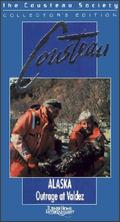 The best sources on Zappa's actual musical activities during the years 1989-1991 are four documentaries that have been
broadcast on national TV in various countries. In 1989 Jacques Cousteau commissioned Zappa to write the music for his
Outrage at Valdez documentary about the environmental disaster by a leaking oil tanker in Alaska. He wrote a synclavier
piece of fifteen minutes, most of it used spread out through the documentary when it got broadcast in 1990.
Visit http://globalia.net/donlope/fz/songs/Outrage_At_Valdez.html for the details. To the right the video of the documentary,
that used to be available via the Cousteau Society. This synclavier piece also got aired
by the NOS on Dutch radio, December 1990, where it got introduced as "the Valdez score by Frank Zappa". "Valdez score"
is since then the title bootleggers came to use for their copies of the radio broadcast. Zappa's comment in the
Yellow shark booklet that only 50 seconds of the 1992 "Outrage at Valdez" composition were used for the documentary
is bound to be misinterpreted. It suggests that these 50 seconds is the only music by him that got used, whereas
what actually is the case is that 50 seconds of "Outrage of Valdez" are present in the "Valdez score". For the largest part
these two pieces are different compositions.
The best sources on Zappa's actual musical activities during the years 1989-1991 are four documentaries that have been
broadcast on national TV in various countries. In 1989 Jacques Cousteau commissioned Zappa to write the music for his
Outrage at Valdez documentary about the environmental disaster by a leaking oil tanker in Alaska. He wrote a synclavier
piece of fifteen minutes, most of it used spread out through the documentary when it got broadcast in 1990.
Visit http://globalia.net/donlope/fz/songs/Outrage_At_Valdez.html for the details. To the right the video of the documentary,
that used to be available via the Cousteau Society. This synclavier piece also got aired
by the NOS on Dutch radio, December 1990, where it got introduced as "the Valdez score by Frank Zappa". "Valdez score"
is since then the title bootleggers came to use for their copies of the radio broadcast. Zappa's comment in the
Yellow shark booklet that only 50 seconds of the 1992 "Outrage at Valdez" composition were used for the documentary
is bound to be misinterpreted. It suggests that these 50 seconds is the only music by him that got used, whereas
what actually is the case is that 50 seconds of "Outrage of Valdez" are present in the "Valdez score". For the largest part
these two pieces are different compositions.
"Outrage at Valdez" as we know it appeared in total on "The yellow shark" from 1993 with a version played by the Ensemble Modern. It's
a relaxed piece of music, well sounding and peaceful. It's in 9/4, just as "Get whitey", to which
it is related. "Outrage at Valdez" has a gentle through-composed main melody, played
along various side melodies. In the "The yellow shark" booklet conductor Peter Rundell rightly calls it a ballad
and talks about the difficult rhythmic relations in it. The transcribed section below isn't that difficult, but you can look
at "Get whitey" in the next section for examples of such difficulties.
The harmonic climate in this composition is strongly determined by the subsequent pedal notes, over which everybody
is playing. The transcribed opening with bars 1-8 is in F minor, played over an F bass pedal note. The staff for the
woodwinds represents the lead melody, the others sort of play around it.
Outrage at Valdez, opening (midi file).
The Valdez score, section (midi file).
Outrage at Valdez, opening (transcription).
The Valdez score, section (transcription).
The subsequent pedal notes and scales, with their starting points, are F minor (0:00), Eb Mixolydian (0:43),
F minor (1:01), F# minor (1:19) and F minor again (1:44). At 1:38 you briefly have a G pedal with the melody modulating
back to F. The composition gets at a closing chord at 2:51 with Bm9. The bass is first
giving the tonic F, followed by a Db at 3:01 for 6 seconds till the end. So it ends with sort of a deceptive cadence. When Zappa used a final chord, specifically in the eighties,
he liked to evade the previous pedal note/chord every once in a while, so that it comes out as a surprise, as
in for instance the following seven instances:
- "Sofa no. 1/2": while the main key of this song is C, at the very end it moves over to a sustained A chord.
- "Crew slut": see the second example from the Joe's garage section.
- "Teen-age prostitute": the apparent B closing chord suddenly moves to a single D (not part of the same scale).
- "Pick me, I'm clean": the apparent D closing chord suddenly moves to a C chord.
- "Be in my video": at the end the song moves over from C to the E and D chords, belonging to a different scale.
- "Jesus thinks you're a jerk": the apparent C closing chord moves to an Eb chord with an A pedal beneath it (as a combination an 11th chord on Eb).
- "Things that look like meat": a solo in G Dorian, that at the very end evades to an Eb7 chord.
- "Penguin in bondage (1988)": while this song is in D Dorian, it ends with a Cm7 chord with an Eb by the bass as lowest note.
"Outrage at Valdez" is also coming by in the Clement study and my discussion with Clement. Clement gives this cadence a different meaning than me.
See the left menu for the details.
In the above transcribed section of "The Valdez score", Zappa is mostly using a self-created scale: B-C#-D#-E-F#-G-A. It's
a variation upon B Mixolydian, using G natural instead of G sharp. A few spots with altered notes turn up. Bars 4 and 7
have a C natural and bar 12 has an A sharp. The bass is playing a slow counterpoint line and there's an upcoming
and fading harmony chord present. The transcription contains varying meters, but they are to a point my notational choices,
so I can't comment upon that aspect with certainty.
Electronic music by FZ - Worms from hell
 The German documentary Peefeeyatko from 1991 shows Zappa working
on the synclavier. Seen his physical appearance, the footage is probably from 1990. This documentary is of specific interest
because it contains various sections of synclavier pieces from that time, a mix of unreleased music and pieces from
"Civilization phaze III" in an earlier state. You can see him building up a composition by entering notes on the keyboard,
speeding things up and combining the result with earlier recorded tracks. He also explains how the sound quality could become
so good (image to the right). He would sample a clarinet tone by picking out the best note humanly played from a series per register, recorded in an ideal
acoustic area. Than the synclavier can vary the pitch and you get a scale of all the chromatic notes. Using it you get an
always perfect sounding clarinet.
The German documentary Peefeeyatko from 1991 shows Zappa working
on the synclavier. Seen his physical appearance, the footage is probably from 1990. This documentary is of specific interest
because it contains various sections of synclavier pieces from that time, a mix of unreleased music and pieces from
"Civilization phaze III" in an earlier state. You can see him building up a composition by entering notes on the keyboard,
speeding things up and combining the result with earlier recorded tracks. He also explains how the sound quality could become
so good (image to the right). He would sample a clarinet tone by picking out the best note humanly played from a series per register, recorded in an ideal
acoustic area. Than the synclavier can vary the pitch and you get a scale of all the chromatic notes. Using it you get an
always perfect sounding clarinet.
Electronic music by FZ, section (midi file).
Electronic music by FZ, section (transcription).
Peefeeyatko contains a section of seven and a half minute with synclavier music, played without interruptions or voice-overs.
In the credits it gets referred to as "Electronic music by Frank Zappa". It's an about fifty-fifty mix of components from "Civilization phaze
III" and music unreleased on CD. It shows how much Zappa was combining and reusing tracks before he came to the definitive
versions on "Civilization phaze III". The above is a section from this "Electronic music by Frank Zappa". It contains a
melody played over a steady pulse played by string instruments. It appears that this melody is either recorded independently
of the pulse or played over it in a rubato manner. At least I'm not hearing a synchronism. Without information about how
such music was constructed, it's difficult to get it on paper with any certainty. So the transcription above is only
one by approximation. In 2011 the ZFT released "Feeding the monkeys at ma maison", where you can hear this fragment as
part of a larger synclavier composition called "Worms from hell". This five minutes piece is centred around variations upon the pulse
as in the transcription from above. The midi file corresponds with 3:39-3:54 from "Worms from hell".
The grand wazoo (1969/1992)
In an interview with Carl Stone from 1988, available on Youtube as https://www.youtube.com/watch?v=VR6CExfYDJs&t=752s, Zappa
talked about a project for releasing synclavier samples: "he [the engineer] is in the process now of preparing for retail sale my sample library.
We are going to have that out by the end of the year called the samples from hell library." Adam Wehby informed me about this.
It looks like this project didn't come off or remained unfinished. Two major synclavier works got completed in 1993, while two more
ZFT releases suggest others projects remained unfinished. See the Civilization phaze III section for more. Another project that got completed
in 1993 is an archive collection called "The lost episodes". It is said that Zappa considered a follow up for this CD too.
The grand wazoo (1969/1992), 0:00-0:04 (midi file).
The grand wazoo (1969/1992), 0:00-0:04 (transcription).
"The lost episodes" concentrates on recordings from the sixties. One synclavier work from around 1992 is included, for which reason I'm including
this example in this section. It is used in combination with a spoken text by Don van Vliet from 1969, called "The grand wazoo".
It is the exact same title as used for a 1972 jazz composition, but has nothing in common with it. Zappa lets pieces from Don's text alternate with
episodes of synclavier music, so the whole becomes a collage. It's not fit for transcribing, but I like to include fragments of such material nevertheless
for reasons of completeness. Like many later synclavier compositions it can only be notated by approximation. I've limited myself to the first four seconds.
In bars 1-3 you can hear a numbers of melodic lines that hold the middle between hocketing and counterpoint, typical of many later synclavier works.
It gets followed by the first sentence from the monologue by Don van Vliet, a part written by Zappa.
Improvisation in A - Budapest solo
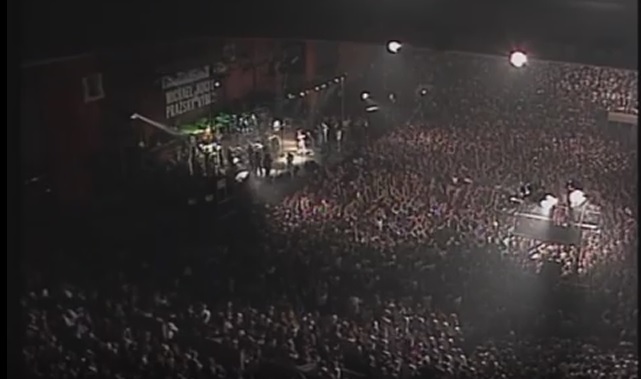 In 1991 Zappa did some guest appearances during his visits of Prague and Budapest, where people were celebrating the ending
of the communist era. Both visits got broadcast on Czech and Hungarian TV channels. In Prague Zappa played one solo with
a group called Praczky Vyber, the "Improvisation in A" from below. After congratulating the audience for their uniqueness,
Zappa introduces this solo as reggae in A (photo to the left). The group then starts with a reggae vamp over A pedal. It's played in a free form.
Traditional reggae has the rhythm guitar consistently playing on the 2nd and 4th beat, but their guitarist is here playing on the first
beat just as well. Zappa plays solo in A Mixolydian for some three minutes, whereafter the guitarist from Prazsky Vyber launches
a duet with Zappa responding to his phrases. Zappa hadn't touched his guitar for about three years before this gig,
but this doesn't show, he's doing fine as usual. Prazsky Vyber included the solo on their "Adieu CA" CD from this concert
and their later "Komplet" compilation.
In 1991 Zappa did some guest appearances during his visits of Prague and Budapest, where people were celebrating the ending
of the communist era. Both visits got broadcast on Czech and Hungarian TV channels. In Prague Zappa played one solo with
a group called Praczky Vyber, the "Improvisation in A" from below. After congratulating the audience for their uniqueness,
Zappa introduces this solo as reggae in A (photo to the left). The group then starts with a reggae vamp over A pedal. It's played in a free form.
Traditional reggae has the rhythm guitar consistently playing on the 2nd and 4th beat, but their guitarist is here playing on the first
beat just as well. Zappa plays solo in A Mixolydian for some three minutes, whereafter the guitarist from Prazsky Vyber launches
a duet with Zappa responding to his phrases. Zappa hadn't touched his guitar for about three years before this gig,
but this doesn't show, he's doing fine as usual. Prazsky Vyber included the solo on their "Adieu CA" CD from this concert
and their later "Komplet" compilation.
Improvisation in A (Prague), opening (midi file).
Budapest solo, section (midi file).
Improvisation in A (Prague), opening (transcription).
Budapest solo, section (transcription).
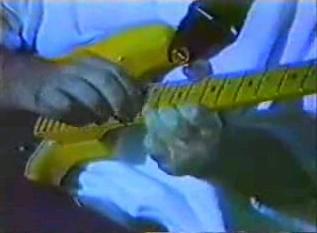 In Budapest Zappa went on stage again with another group at a site called Taban. Two of his solos could be heard during the Zappapest
documentary, that was broadcast that year. The section above contains a section of the second solo in 3/4, where
he's extracting notes out of his guitar as fast as possible. He had done this before towards the end of "St. Etienne".
In an interview he explained that for creating this effect of speed he didn't have to pick every individual note. It's a
combination of bending the strings and picking them, not necessarily synchronous. On video it indeed looks less
phrenetic as the notes suggest (still to the right). It's still possible to hear the individual notes for a transcription. With
its a:b formula, the note system supports any rhythmic relationship. The more precise you're notating sections
like this, the more unreadable it gets however. The transcription above has drifted far away from sight reading.
In Budapest Zappa went on stage again with another group at a site called Taban. Two of his solos could be heard during the Zappapest
documentary, that was broadcast that year. The section above contains a section of the second solo in 3/4, where
he's extracting notes out of his guitar as fast as possible. He had done this before towards the end of "St. Etienne".
In an interview he explained that for creating this effect of speed he didn't have to pick every individual note. It's a
combination of bending the strings and picking them, not necessarily synchronous. On video it indeed looks less
phrenetic as the notes suggest (still to the right). It's still possible to hear the individual notes for a transcription. With
its a:b formula, the note system supports any rhythmic relationship. The more precise you're notating sections
like this, the more unreadable it gets however. The transcription above has drifted far away from sight reading.
Roland's big event/Strat Vindaloo
In 1991 the rehearsals with the Ensemble Modern started. Zappa was present on different occasions and these sessions were also used to experiment. Various of these experimental try-outs landed on "EIHN", to be
dealt with in the next section of this study. Footage also exists in the shape of the AAAFNRAA documentary.
This paragraph is about so-called world-music in Zappa's output. It's present, but its influence is marginal:
Latin music
- "Bossa Nova Pervertamento" (see the Projects section of this study).
- The "Be-bop tango" and the "Sheik Yerbouti tango" (see the Roxy and Elsewhere section).
- The Latin rhythm of the interlude from "Father O'blivion" (see the Apostrophe section).
- "Variations on the Carlos Santana secret chord progression" (see the Shut up 'n play yer guitar section for the vamp or the FZ Guitar book).
- A couple of bars from "Emperor of Ohio" (see the YCDTOSA section).
Eastern music
- The emphasis on pedal notes as in "Friendly little finger" and "Canard du jour".
- The appliance of the whole-tone scale in "Echidna's arf (of you)" and the "Sheik Yerbouti tango" (see the Roxy section).
- The melismatic Arab-like bars from my "Filthy habits" and "Planet of the baritone women" examples.
- The "Almost Chinese" lick from my Lumpy Gravy section.
- On track 5 of disc 1 of the 2019 ZFT release "Halloween 73", Zappa describes "T'Mershi Duween" as a "pseudo-Middle-Eastern tune" (see the next Yellow shark section
for an excerpt from this title).
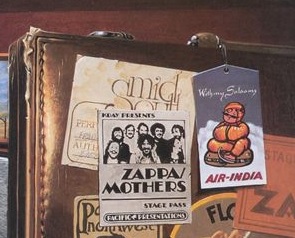 "EIHN" is of interest in this context because it contains a full-blown Indian piece, called "Roland's big event/Strat Vindaloo".
It starts with clarinetist Roland Diry improvising, followed by Zappa on guitar and Shankar on electric violin. See the Joe's garage section for more
about Zappa's collaboration with Shankar.
Zappa liked Indian music
and once considered flying to India, but eventually didn't go (the "Overnite sensation" album cover refers to this (image to the left)).
A pity, because it's a nice country. You don't have to worry about the temperature (the heat is for free) and the collection and disposal of garbage is privatized.
Zappa wasn't a traveller by nature and mostly went were it was profitable
to hold concerts. This could include Eastern Europe, Japan and Australia, but apparently not Latin America.
"EIHN" is of interest in this context because it contains a full-blown Indian piece, called "Roland's big event/Strat Vindaloo".
It starts with clarinetist Roland Diry improvising, followed by Zappa on guitar and Shankar on electric violin. See the Joe's garage section for more
about Zappa's collaboration with Shankar.
Zappa liked Indian music
and once considered flying to India, but eventually didn't go (the "Overnite sensation" album cover refers to this (image to the left)).
A pity, because it's a nice country. You don't have to worry about the temperature (the heat is for free) and the collection and disposal of garbage is privatized.
Zappa wasn't a traveller by nature and mostly went were it was profitable
to hold concerts. This could include Eastern Europe, Japan and Australia, but apparently not Latin America.
Roland's big event/Strat Vindaloo, section (midi file).
Roland's big event/Strat Vindaloo, section (transcription).
The Indian atmosphere is effectuated by a number of elements:
- The odd subdivision of the meter, being 3+3+2 as in for instance bars 2 and 5, followed by the figure from bar 6, beginning with a syncope.
Thus basically a vamp of two bars, but it keeps being varied upon.
- The Indian type of scale, A-Bb-C#-D-E-F-G#.
- The frequent occurrences of chromatic passages.
Other than the title suggests (very spicy), the atmosphere is relaxed. The example above is happening at the transitional part of this track, with the
soloists changing. During bars
1-4 you have the end of Roland's clarinet solo. Bar 6 in 3/8 is not an intentional change of meter. It stems from editing out the applause
Roland received at the end of his solo on the original tape (as explained in the "EIHN" booklet). After this the original meter returns with
Zappa on guitar. At first Shankar is only playing lightly in the background. Next to the percussion section, you can also hear harmonic fill-in
on the piano every once in a while. Everybody is improvising, also the bass vamp gets varied upon. It makes the transcribing of it fatiguing,
at least if you want to do it rather exact. The result is a nice oddity in Zappa's catalogue, once again stressing the wide range of styles
happening in his music. Though the sound is outspoken Indian, no specific Indian instruments are being used to achieve this effect.

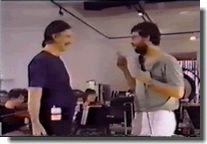
Above: two stills from the AAAFNRAA documentary, featuring the Ensemble Modern rehearsing with Zappa. I don't know who has the rights to all the footage of the material referred to in this section.
Various copies, stills and photos are circulating on the internet. A DVD and/or a CD would be welcome, especially since
there's so little else from this time before the rehearsals
with the Ensemble Modern started during the fall of 1991. The quality of the music also justifies a wider distribution.
